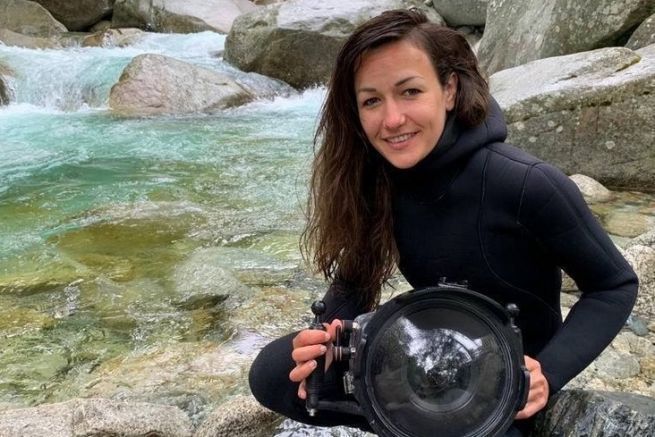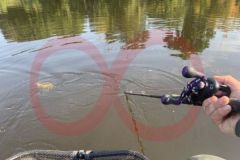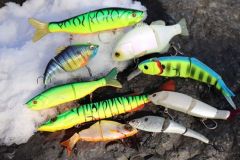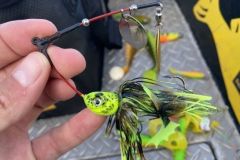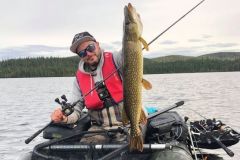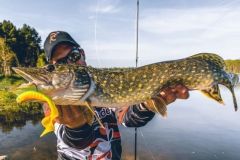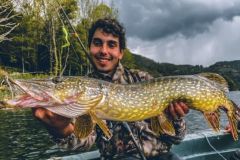Hello Anne-Cecile, thank you for being here! Can you first introduce yourself to the readers of Pêche.com Magazine?
Anne-Cécile Monnier âeuros Hello everyone, I am delighted to be able to share my work and my passion through these few lines. First of all, I am originally from Lorraine where I studied in the management of aquatic environments and water resources in the framework of a Master 2 at the University of Metz. My first internship took me to the Rhône basin where I followed the Rhone shad for a few months. It is certainly at this moment that I fell in love with the hydrobiologist's job and with fish.
What does your job as a hydrobiologist involve on a daily basis?
Anne-Cécile Monnier âeuros The basic concept of this profession is the study of the life of rivers. As far as I am concerned, I specialized in the study of freshwater fishes and at the beginning in the study of the impact of dams and obstacles to the flow on migratory fishes (shad and eels in particular) and smaller migratory fishes like pike or trout for example. I then worked for several years for different research offices in the South of France, then in Brittany to work on the eels of the Loire River where we proceeded, among other things, to the marking of elvers (young eels) and to their follow-up to evaluate the growth of this fish in the natural environment. Finally, I came back to Lorraine for a few years where I worked again on several impact studies on the Meuse and the Seine tributaries, and I am now based in the Paris region.
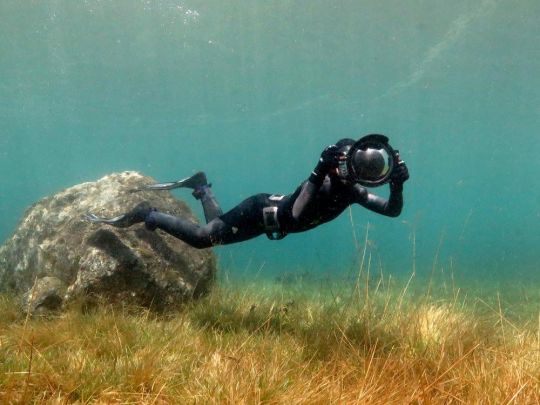
You are part of the microcosm of "freshwater underwater image reporters" in France. Where did this desire to dive come from, to go to the other side of the mirror?
Anne-Cécile Monnier âeuros Everyday, the job of a hydrobiologist is a lot of observation in the field and it is in this context that I started to dive, snorkeling (fins, mask and snorkel), to go and spot potential nests of sea lampreys, or to observe the blockage of shads at the foot of dams for example. I realized that there was a lot of things to highlight. My father then offered me a small waterproof compact camera which allowed me to make my first pictures ten years ago now. Given the interest that my entourage had in these images, I realized that underwater photography was a good way to make the link between what happens underwater, the scientific world and the general public. Everything finally came together so that I could combine a scientific and artistic approach.
Can you tell us about your association "Reflets d'eau douce", its objectives, and the actions you carry out through this association?
Anne-Cécile Monnier âeuros The objective of the association "Reflets d'eau douce" is to communicate on freshwater biodiversity to the general public. From 2014 to 2019, I was self-employed in hydrobiology, which allowed me to develop this project that was close to my heart. Initially " Freshwater Reflections "was a website that I created to share articles on hydrobiology as well as my photos. Gradually, the desire to share with the public became stronger and stronger and we decided with other enthusiasts to set up the association " Freshwater Reflections "In 2015, I created a project to promote water education in schools, conferences and photographic exhibitions. For a few years I have also been making documentary films for water stakeholders.
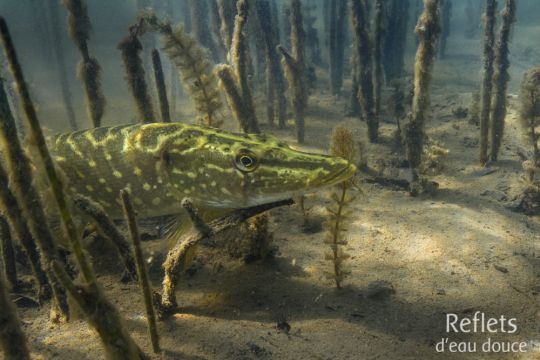
The fact that I went from photography to documentary is not surprising, but they are two very different disciplines. What was the trigger?
Anne-Cécile Monnier âeuros It all started with a fishing enthusiast, now my friend, Pierre Pommeret, at the time Technical Manager at the Meurthe et Moselle Fishing Federation in Nancy. Knowing my photographic work, he asked me to make a film to promote the actions underway to restore pike spawning grounds on the Moselle River. For a year I shot images highlighting the work done by the 3 fishing federations that manage the French Moselle. A very big project for which I had to train directly in the field! Everything went very well and I had afterwards other propositions of films and in particular a follow-up of two years on the pikes of the Meuse following a study of marking and behavioral follow-up. (The films are online on the YouTube channel "Reflets d'eau douce").
Since then, you have come a long way since you have directed films for Seasons or Ushuaïa TV, among others, in addition to commissions for fishing federations.
Anne-Cécile Monnier âeuros For Seasons, we wrote with Pierre Pommeret a film about the arrival of gobies in France, from the Danube basin. We wanted to meet fishermen in order to collect their experiences, their questions, their observations but also those of scientists who study these gobies for several years at the University of Lorraine, and we have among others involved the French Office for Biodiversity (OFB). It is a 52 minutes for television that aims to provide answers to fishermen and especially to better understand this fish, to be able to differentiate it from the sculpin (the goby has a suction cup, by the fusion of its two pelvic fins), to distinguish the 4 species of gobies present, to understand how they arrived in France (by the ballast water of the barges!) and to know what can be done to limit their spread. To date in 2020, the goby is considered in France as an exotic fish that can be released only at the place of capture and that we are not allowed to transport alive, nor to use as bait! The film will be broadcasted on November 4, 2020 on the Seasons channel.
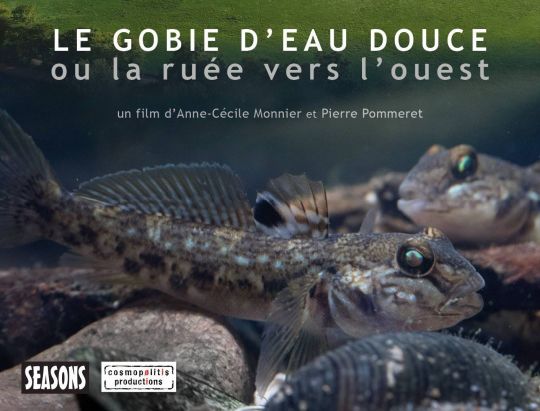
Concerning my projects with Ushuaïa Tv, this time it is an embodied series whose principle is to follow a hydrobiologist underwater photographer on unknown rivers in the French overseas territories. With Anthony Binst, the director, we did a first episode in Tahiti to meet its sacred eels, fish that can weigh up to 20 kg for 2 m long! I went to meet local residents and scientists to understand how this eel is protected, not by a law but by a belief, the legend of the sacred eel� The film was broadcast on the Ushuaïa Tv channel this summer and other broadcasts are planned for the coming months.

The objective of the MEL'EAU Network, like your work as a whole, is to raise awareness of the absolute necessity of preserving aquatic environments, but here the strategy to achieve this is singular. Can you tell us about it?
Anne-Cécile Monnier âeuros Through the association "Reflets d'eau douce" I intervene in schools all over France and overseas during my shootings. With my counterpart Aurélie Grondin, whom I met in Reunion in 2014, we have developed the MEL'EAU network, which brings together classes in France and overseas on water class projects. The students learn to discover the biodiversity of their rivers, which they will present to their pen pals by video conference. The objective is to raise awareness that our environments are unique and precious and that it is absolutely necessary to preserve them. We continue by developing this program on other territories. After Guyana two years ago, French Polynesia joined the project this year.
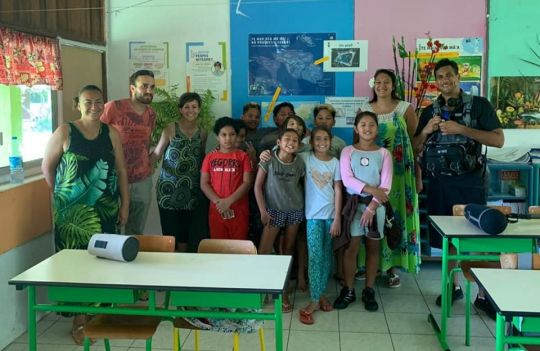
What are your plans for the future?
Anne-Cécile Monnier âeuros There are many! Many events planned for the distribution of my book "Under the surface, encounters in the heart of our fresh waters" released in 2019, and the continuation of several film shoots in progress. In addition, I wish to continue to develop the MEL'EAU Network to other territories.
What would be your message for the rivers of tomorrow?
Anne-Cécile Monnier âeuros Through all the uses of water, whether it is agricultural practices, domestic or industrial use and discharges, land use planning, urbanization and waterproofing or land drainage, the contribution of new species from other continents, all have an impact on the aquatic environment. The river is a record of all these problems. The state of a river is in a way the reflection of the World in which we live.
Also, we would need to focus more on the qualitative aspect of the river. In our time, and because we are going through more and more frequent periods of drought, we are focused on the quantity of water available but the quantity and quality of water are intrinsically linked.

 /
/ 